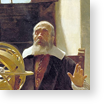
The relics exhibited at the Museo Galileo illustrate the celebration of Galileo as hero and martyr of science. On March 12, 1737, Galileo's remains were moved from his original grave to the monumental tomb erected in the Basilica of Santa Croce, in Florence. The transfer was arranged by Vincenzo Viviani (1622-1703), his last, affectionate disciple. On this occasion, three fingers and a tooth were removed from Galileo's body. The construction of the tomb and the transfer of the remains eloquently demonstrated the strong resolve of the last Medici ruler of Tuscany, Grand Duke Gian Gastone (1671-1737), to assert the State's autonomy from ecclesiastical interference.
The room dedicated to Galileo also presents examples of his celebration in art: the bust by the sculptor Carlo Marcellini, two oil paintings (by Tito Lessi and Annibale Gatti respectively), and a medal attributed to Giovanni Battista Foggini.
Bust of Galileo Galilei
Inv. 3902
Carlo Marcellini, 1674-1677
Galileo and Milton
Inv. 3682
Annibale Gatti, second half 19th cent.
Galileo and Viviani
Loan INAF-Arcetri
Tito Lessi, 1892
Middle finger of Galileo's right hand
Inv. 2432
Author unknown, Stand, case, and inscription: ca. 1737












